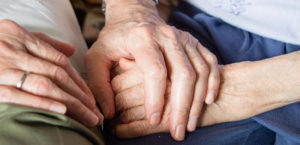Deacon Miguel Sainz’s thoughtful answer to that question would have bombed in a job interview, but it helped secure a spot in one of the archdiocese’s early classes for the permanent diaconate.
“I have no idea what it is I want to do,” he said more than four decades ago. “I will do whatever the Lord wants me to do.”
“You think the Lord is going to tell you?” the interviewer pressed.
“Yes, I do,” Deacon Sainz said.
Over the years, he has answered that call, from serving an exploding community of Hispanic Catholics, to raising six children, to taking tender care of his Alzheimer’s-stricken wife, to awaiting Pope Francis’ visits to his native Cuba and his adopted U.S.
The former refugee, now 80, celebrated the 40th anniversary of his ordination June 7.

In his formative years, Deacon Sainz witnessed the rise of the brutal regime of Fulgencio Batista, and its overthrow at the hands of Fidel Castro.
“In the beginning, everybody was with Castro, because everybody was happy to get rid of Batista,” Deacon Sainz recalled in a recent interview with the Catholic Review at his Towson residence.
When Castro declared his Communist affiliation, however, life changed, according to Deacon Sainz.
“They started indoctrinating the children,” he said. “They got rid of priests and nuns.”
Deacon Sainz and his wife, Isabel, had an infant son, and she was pregnant with another.
“It was difficult to find milk or anything, so it was time to leave,” Deacon Sainz remembered.
The Sainzes applied for and received exit visas and left for the U.S. in 1962. Soon after they left, flights to the U.S. from Cuba were stopped.
The family gave up everything to start over.
“When we left, (Cuban officials) went through the house and took an inventory,” Deacon Sainz remembered.
“Everything was to be given to them.”
Once in the U.S., the family made its way to Baltimore, as Deacon Sainz found work in the electrical industry in nearby Washington. The family settled on Harwood Avenue and became parishioners of St. Mary of the Assumption in Govans, where the deacon has served ever since.
He wasn’t always a religious man. He credits his wife with opening that door.
“She started talking about God,” he remembered of one of their early dates. “I said, ‘OK, we’ll talk about God.’”
Deacon Sainz’s faith grew more fervent after he met a devotee of the Cursillo movement, in which participants strengthen their relationship to God over a three-day retreat.
“I had a pretty deep religious experience that changed my whole life,” Deacon Sainz remembered. “I had more of a personal relationship with the Lord, Jesus and the Holy Spirit, and that was the beginning of my new life.”
It has been an active one. He became the Archdiocese of Baltimore’s first Hispanic deacon, and St. Mary of the Assumption’s first deacon, period.
“Miguel had a great spiritual life and he was a very warm person,” remembered retired Monsignor Thomas J. Tewes, pastor of St. Mary when Deacon Sainz was ordained. “He was a great asset to the parish at the time and has been ever since.”
Deacon Sainz has also been indispensable to the archdiocese’s Hispanic community, which has grown immensely from the small pockets of the late 1970s. He found himself preaching to the immigrant community in his own parish and beyond, to an ever-expanding circuit including what is now the Esperanza Center in Upper Fell’s Point, the now-closed St. Michael in Butchers Hill, Sacred Heart in Glyndon, Resurrection of Our Lord in Laurel and Catholic Community of St. Francis Xavier in Hunt Valley.
“A lot of these places had small groups of Hispanics,” Deacon Sainz remembered, adding that today, some have “huge Spanish Masses.”
Deacon Sainz received the Pro Ecclesia et Pontifice, a papal medal, from St. John Paul II in 1982. When the pope came to Baltimore in 1995, the deacon and his wife were among his audience at the Cathedral of Mary Our Queen in Homeland.
After the event, recalled Deacon Sainz, “(Cardinal William H. Keeler, now archbishop emeritus of Baltimore) called me. He said, ‘We have a picture of the Holy Father with your wife. Do you want it?’ ”
Today, the photo is among the Sainz’s most prized possessions.
In addition to his ministry, the 6-foot-4 Deacon Sainz managed to earn three degrees from The Johns Hopkins University, including two master’s degrees, and settle into a job for the Baltimore Gas and Electric Company, from which he retired in 2000. His and Isabel’s six children gave them 17 grandchildren (all baptized by their grandfather), and the couple is awaiting their first great-grandchild.
Due to her Alzheimer’s disease, Isabel, 78, requires full-time care. Though Deacon Sainz still preaches a couple times a month, his wife’s needs are now a major focus of his ministry. The couple will celebrate their 55th wedding anniversary Aug. 21.
Deacon Sainz has high hopes for his former country, and credits Pope Francis with breaking some of the barriers between the U.S. and Cuba.
“Obama went to Rome, and then Raúl Castro went to Rome, and after that (Obama and Castro) got together,” the deacon said. He applauded the restoration of relations between Cuba and the U.S., and hopes to see the end of the embargo between the two countries, a somewhat unusual stance for a first-generation refugee from Cuba.
“If I said that in Miami, they might throw me to the alligators,” Deacon Sainz joked.
An end to the embargo, he argued, would improve the quality of life for everyday Cuban citizens, while simultaneously allowing them to see the possibilities outside of Communism.
The deacon also believes that Pope Francis’ visit to Cuba – scheduled for Sept. 19-22, just before he comes to the U.S. – could be of huge benefit to the country’s citizens.
“I think he’s incredible, really,” Deacon Sainz said. “He’s so different and cares so much for the poor … I wonder what he’s going to do in Cuba?”

